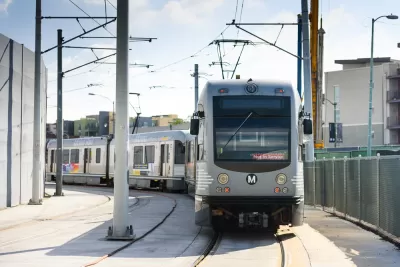Already delayed, the Crenshaw Line has now sparked debate between stakeholders who favor opposing visions of how the light rail service should link up with the existing Green Line.

Now expected to open in the summer of 2020, L.A.'s Crenshaw Line is set to intersect with the Green Line, which runs primarily east-west along the 105 Freeway. But a section of the Green Line also runs past LAX and south to Redondo Beach, and elected representatives for that area are concerned about Metro's favored option for managing the connection.
That plan, Laura J. Nelson writes, "would break the Green Line into two pieces at Aviation Boulevard. Riders along the portion of the line that runs along the 105 would be able to board a train every six minutes during peak periods and ride west and north to the Expo Line without transferring. But riders going to or coming from the South Bay's four Green Line stations, the portion of the line with the lowest ridership, would lose their one-seat ride."
Those riders, who account for only 12 percent of the Green Line's ridership, would be forced to "transfer from the Green Line to the Green Line," as Los Angeles County Supervisor Janice Hahn put it. Her district includes Redondo Beach.
But an alternative plan to preserve South Bay riders' one-seat trip would essentially oblige the new Crenshaw Line to run two-car trains, even though it could handle three-car ones, due to the older Green Line's electrical limitations. Metro's directors will decide the issue at a board meeting on December 6. Ultimately, a planned extension of the Green Line to Torrance in the mid-2020s will change the math here once again.
FULL STORY: Westside and South Bay clash over how to connect two rail lines

Maui's Vacation Rental Debate Turns Ugly
Verbal attacks, misinformation campaigns and fistfights plague a high-stakes debate to convert thousands of vacation rentals into long-term housing.

Planetizen Federal Action Tracker
A weekly monitor of how Trump’s orders and actions are impacting planners and planning in America.

In Urban Planning, AI Prompting Could be the New Design Thinking
Creativity has long been key to great urban design. What if we see AI as our new creative partner?

King County Supportive Housing Program Offers Hope for Unhoused Residents
The county is taking a ‘Housing First’ approach that prioritizes getting people into housing, then offering wraparound supportive services.

Researchers Use AI to Get Clearer Picture of US Housing
Analysts are using artificial intelligence to supercharge their research by allowing them to comb through data faster. Though these AI tools can be error prone, they save time and housing researchers are optimistic about the future.

Making Shared Micromobility More Inclusive
Cities and shared mobility system operators can do more to include people with disabilities in planning and operations, per a new report.
Urban Design for Planners 1: Software Tools
This six-course series explores essential urban design concepts using open source software and equips planners with the tools they need to participate fully in the urban design process.
Planning for Universal Design
Learn the tools for implementing Universal Design in planning regulations.
planning NEXT
Appalachian Highlands Housing Partners
Gallatin County Department of Planning & Community Development
Mpact (founded as Rail~Volution)
City of Camden Redevelopment Agency
City of Astoria
City of Portland
City of Laramie




























